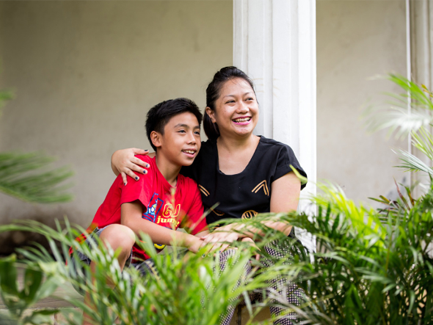
Tips for talking to your teenager
How to support and communicate with your teenager as they take on more T1D responsibilities, plus tips for raising teens with diabetes.
Meet the caregivers who provide support to children with type 1 diabetes
Diabetes in children occurs when the body struggles to control blood glucose levels, leading to high blood sugar (hyperglycaemia)1.
While both conditions affect blood sugar and can exhibit some similar symptoms, type 1 diabetes in children usually requires insulin from the time of diagnosis3. Depending on the severity of the condition, Type 2 can sometimes be managed with healthy lifestyle changes. However medication is normally also required as part of a child’s treatment plan2.
There are both similarities and differences in the causes of type 1 and type 2 diabetes in children.
It’s important to note that type 1 diabetes in children cannot be prevented. However, factors such as diet, lifestyle, or consuming too much sugar should be carefully managed to help prevent long-term complications1,4.
Healthy habits can lower the risk of developing type 2 diabetes in children. Balanced nutrition - including carbohydrate counting to help prevent childhood obesity, staying active, and maintaining a healthy weight all make a difference2.
Understanding what diabetes symptoms to look out for in your child is vital, so you can get them the medical support they need quickly and when required.
In type 1 diabetes, these symptoms may appear over just a few days or weeks and worsen quickly, making urgent medical care essential5,6.
The symptoms of young people with type 2 diabetes are broadly the same as for type 1, but they often develop more slowly and can be less noticeable. This means they may build up over weeks or months rather than appearing suddenly5.
If you notice any of the symptoms listed in the above section present in your child, please contact your doctor to arrange an appointment. At the appointment your doctor can carry out an assessment, including a review of your family’s medical history and blood glucose test, to confirm whether or not your child has type 2 diabetes5.
If your child is diagnosed with type 1 or type 2 diabetes it may at first feel overwhelming for them and your family, especially considering the potential for various health problems. However, with the right support and management, including attention to environmental factors and mental health, children living with diabetes can still lead healthy, active, and fulfilling lives, which is crucial to avoid additional life threatening risks like heart disease and kidney disease1,2.
Children with diabetes may sometimes feel different from their peers, especially when needing to check blood sugar or take a blood glucose test to manage low blood sugar and insulin multiple times during school or social activities. Parents, teachers, and healthcare teams can help by:
With consistent care, a diabetes diagnosis does not need to hold your child back from living a full and active life. Many kids with type 1 diabetes thrive in education, sports, and friendships just like their peers1.
Yes. With the right care and support, children with diabetes can live full, healthy, and active lives. Managing diabetes means keeping blood sugar in balance through a combination of healthy eating, regular exercise, blood sugar monitoring, and (for type 1 diabetes) daily insulin to ensure enough insulin is present. At first, this can feel overwhelming, but over time it becomes part of a normal routine.
A child can develop diabetes at any age, from infancy through their teenage years. Type 1 diabetes is the most common form in children and often appears suddenly, usually between ages 4 and 14, but it can be diagnosed in babies and toddlers as well. Type 2 diabetes, which used to be seen mainly in adults, is now increasingly found in older children and teenagers, especially those who are overweight or have a family history of the condition.
It depends on the type of diabetes. Type 1 diabetes often develops quickly, and symptoms such as thirst, frequent urination, or weight loss can appear within just a few weeks. Because it progresses fast, it usually does not go unnoticed for very long before a child becomes very unwell and needs medical care. Type 2 diabetes, on the other hand, can develop more slowly, and some children may have it for months - or even years - without clear symptoms.
HQ25DI00221
